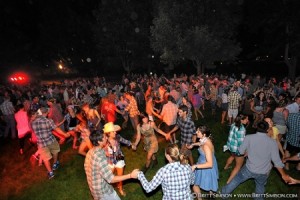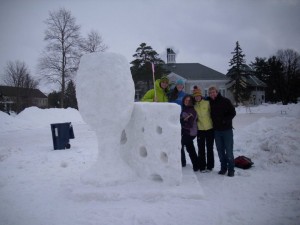In case you can’t make it to campus, or you forget things about the tour you did go on, here is a brief summary of a typical tour during the summer. We hope you enjoy this mini-tour, and hopefully you’ll have time to make it here for a live tour with one of our smiling tour guides! Here’s a link to our campus map in case you want to situate yourself on campus as you read about buildings.
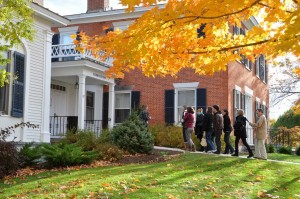
We start here in the Admissions office, of course. We introduce ourselves and find out a little about you, but then we start our backwards walking and begin the tour.
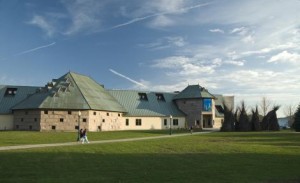
Our first stop is the Mahaney Center for the Arts (CFA). This is our arts building for dance, music, and theater. Visual arts are in a different section of campus. Inside this building, we have many facilities that are open to all students regardless of their major. Some of the facilities include the Seeler Studio Theater, one of our three theaters on campus for faculty-directed shows, the Dance Studio with sprung floors for dance classes and performances, the Museum of Art, and the Concert Hall, a magnificently acoustic room, for visiting and student performances. We have several theater productions throughout the year, a few faculty-directed and several student-directed shows. We also have the Middlebury College Musical Players (MCMP) which is a student-run group that performs musicals, and one faculty-directed musical during J-term. Our musical groups include the Chamber Music Ensemble, the College Orchestra, the Jazz Ensemble, the College Choir, and Glee Club. There are many opportunities for dance as well, from classes for credit to the Dance Company of Middlebury to MiddDance, OnTap, and Riddim, our student-run groups.
After the CFA, on our way to the next building, we pass the athletic center. Again, all the facilities are open to anyone, even if you are not an athlete. We have an Olympic-sized swimming pool, basketball courts, a hockey rink, tennis courts, squash courts, an indoor track, and a rock climbing wall, among other things. There are about 600 Varsity athletes at Midd, and we are a Division 3 school. Aside from Varsity sports, we have some Junior Varsity, club, and intramural sports. Intramurals are a lot of fun with lighthearted competition between friends to win the coveted Intramural Championship t-shirts.
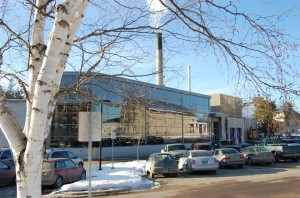
We also pass by the Biomass plant before entering the next building. Middlebury has pledged to become carbon neutral by 2016, and the Biomass plant helps out the initiative by using wood chips instead of oil to fuel a lot of our campus. In fact, it reduces our carbon footprint by 50%. In addition to the Biomass plant, we have recently added a solar farm behind our science center to help us on our path to carbon neutrality.
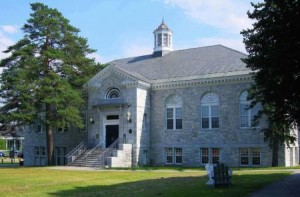
Our second stop on the tour is the McCullough Student Center. This is where the CCAL (Center for Campus Activities and Leadership) and MCAB (Middlebury College Activities Board) offices are held. CCAL oversees the 140+ student organizations and the many student activities that happen throughout the year. MCAB is made up of a group of student committees who facilitate activities on campus. Some examples are speakers that they bring to Middlebury, including the Dalai Lama, Homecoming weekend, Free Friday Films, and our big end of term concerts (including Kid Cudi, Wale, and Guster). Inside McCullough is the Social Space, where a lot of these activities happen. Some more specific events we’ve had in the Social Space are hypnotists, comedians, ‘80s dance parties, and swing dances. Across from the Social Space is the Grille and Crossroads Café downstairs. These are social areas with delicious food (not included in the meal plan) and are great places to hang out.
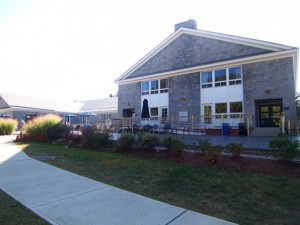
Proctor Dining Hall comes next. One of our three dining halls, Proctor serves up many delicious choices. Always salad, sandwiches, soup, hot entrées, and fruit, there’s a multitude of items to decide between. If none of those entice you, there are also Panini makers for the more creative souls. In Ross, another dining hall, the Panini makers are replaced with different pizzas. Atwater has pizza as well, and all of our dining halls are staffed by different chefs who choose what to create for us every week. We do not have a meal plan at Middlebury, which is fantastic. Meals are included in the comprehensive fee, and so you never have to worry about how many meals you have eaten in a certain week. You can eat whenever, wherever, and however much you would like. It’s brilliant.
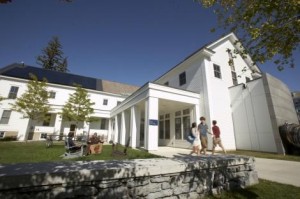
After the dining hall, we pass the Janet Halstead Franklin ’72 and Churchill G. Franklin ’71 Environmental Center at Hillcrest, or Hillcrest for short. This is our environmental studies building, and it was created with environmentally friendly architecture with solar panels, low-flow faucets, and energy efficient windows and lights, among other things. It was the first building in Vermont to receive LEED Platinum, which is the highest designation awarded for Leadership in Energy and Environmental Design. Environmental Studies is one of our more popular as well as well-renowned majors, and is interdisciplinary in nature. If you choose to major in ES, you also must choose a focus, which could be one of many different areas, including, but not limited to, Economics, Food Studies, and Architecture.
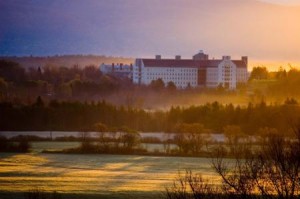
Next stop: McCardell BiCentennial Hall. Built in 2000, it includes all of our sciences from Chemistry, Biology, and Physics, to Geology, Geography, Astronomy, and Psychology. BiHall has a science library, a greenhouse, an observatory, and several classrooms and labs. There are many research opportunities for us undergrads in BiHall, and there are students living on campus every summer doing research. Research can be done for pay or for credit during the school year, too.
As for general academics, we do have distribution requirements. We have 8 distribution requirements, but you only need to fulfill 7 of them. They are Deductive Reasoning, Natural Science, Social Science, Philosophy/Religion, Art, Language, Literature, and History. (Don’t worry; it’s pretty easy to get these. It’s almost as if they fall into place without much effort, although you may have to work to find one or two.) We also have cultural requirements where you have to take a class about each of three regions of the world and one comparing cultures. These requirements include EUR (Europe), NOR (North America), AAL (Africa, Asia, Latin America), and CMP (Comparative). This requirement is important so that MiddKids are not ignorant of the world when they leave Middlebury.
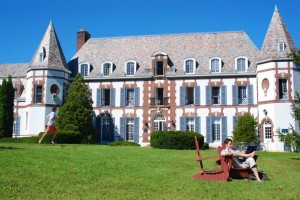
As we leave BiHall, ahead of us is Le Château. If you couldn’t guess by the name, this is our French department. It also houses juniors and seniors upstairs, and you do not need to be able to speak French to live there. If you do want to live in a house where people speak a language other than English, you can choose to live in a language house after your freshman year. The language houses also have different activities open to anyone who can and wants to speak that language. French, for instance, has French films and a café every week. Le Château also houses a theater in the basement for foreign language productions.

Now on to housing. Battell Hall houses 2/5 of the freshman class. 2 of the 5 Commons are associated with Battell. At Middlebury, we have a Commons system where the student body is split into 5 smaller communities. These are Atwater, Ross, Cook, Wonnacott, and Brainerd. You get placed into your Commons randomly based on what First Year Seminar you choose, and then you live with the people in your Commons for your first two years. After sophomore year, you are still affiliated with your Commons, but you do not have to live with them anymore if you so choose. You can still attend your Commons’ dinners and activities, like fondue Fridays or hikes, but you have a chance to live with some people other than those in your Commons. Commons have a great support network with Faculty Heads, the Commons’ Dean, First Year Counselors, and the Commons Residential Advisor (a recent Middlebury grad who knows the ropes since they were here for four years). It’s nice to have a Dean who knows who you are rather than one who you might never meet because they are in charge of 2449 other students. Battell Beach is the expanse in front of Battell. We use this space in all types of weather, for pick up soccer, frisbee, capture the flag, snow ball fights, and, of course, quidditch.

Next we have the Davis Family Library, our new library. There are over one million volumes here, and there are DVDs you can take out, too. The Technology HelpDesk is fantastic, and they know everything there is to know about PCs and Macs. In the back of the building is the CTLR (Center for Teaching, Learning, and Research). Here, we have people who can help you schedule your life, peer tutors for specific subjects, and peer writing tutors. You can just walk-in or make an appointment for anything you might need help in. The library is open until 1am on weekdays during the year, and 11pm on weekends. During exam week, it’s open 24/7. Right outside the library is the Wilson Café, open 24/7 as a study space, and other times as a café.
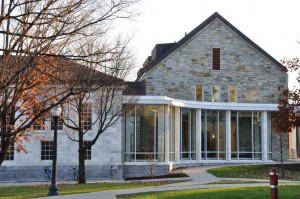
Last stop on the tour is Axinn, or the Donald E. Axinn ’51, Litt. D. ’89 Center for Literary and Cultural Studies at Starr Library. What used to be our old library before the Davis Family Library was built turned into our American Studies, English, and Film and Media Culture Studies building. Inside are many different study spaces, as well as classrooms, screening rooms, a movie theater, and an indoor waterfall.
That’s just a small taste of what our tours are like. We hope you enjoyed it and that you have a chance to come visit us sometime!
